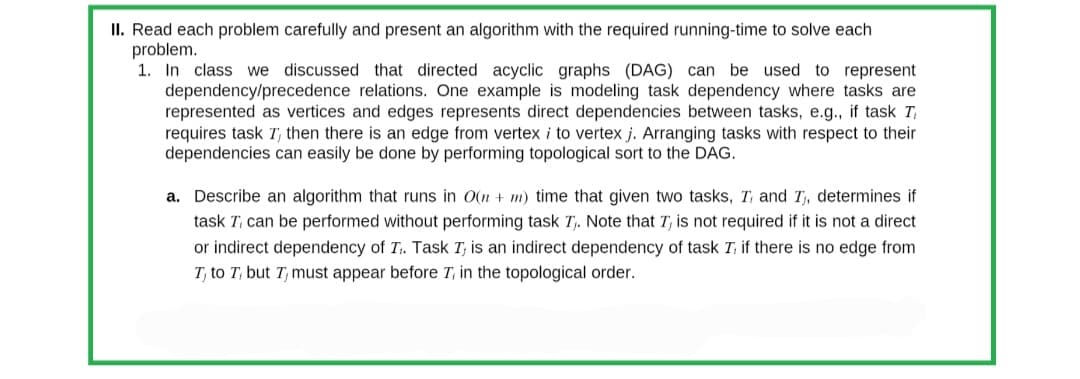1. In class we discussed that directed acyclic graphs (DAG) can be used to represent dependency/precedence relations. One example is modeling task dependency where tasks are represented as vertices and edges represents direct dependencies between tasks, e.g., if task T requires task I, then there is an edge from vertex i to vertex j. Arranging tasks with respect to their dependencies can easily be done by performing topological sort to the DAG. a. Describe an algorithm that runs in O(n + m) time that given two tasks, T, and I, determines if task T, can be performed without performing task T₁. Note that I, is not required if it is not a direct or indirect dependency of T. Task T, is an indirect dependency of task I, if there is no edge from T, to T, but I, must appear before T, in the topological order.
1. In class we discussed that directed acyclic graphs (DAG) can be used to represent dependency/precedence relations. One example is modeling task dependency where tasks are represented as vertices and edges represents direct dependencies between tasks, e.g., if task T requires task I, then there is an edge from vertex i to vertex j. Arranging tasks with respect to their dependencies can easily be done by performing topological sort to the DAG. a. Describe an algorithm that runs in O(n + m) time that given two tasks, T, and I, determines if task T, can be performed without performing task T₁. Note that I, is not required if it is not a direct or indirect dependency of T. Task T, is an indirect dependency of task I, if there is no edge from T, to T, but I, must appear before T, in the topological order.
Computer Networking: A Top-Down Approach (7th Edition)
7th Edition
ISBN:9780133594140
Author:James Kurose, Keith Ross
Publisher:James Kurose, Keith Ross
Chapter1: Computer Networks And The Internet
Section: Chapter Questions
Problem R1RQ: What is the difference between a host and an end system? List several different types of end...
Related questions
Question
I WILL UPVOTE. I REALLY NEED DIFFERENT ANSWERS SO PLEASE SKIP IF YOU ALREADY DiD THIS.

Transcribed Image Text:II. Read each problem carefully and present an algorithm with the required running-time to solve each
problem.
1. In class we discussed that directed acyclic graphs (DAG) can be used to represent
dependency/precedence relations. One example is modeling task dependency where tasks are
represented as vertices and edges represents direct dependencies between tasks, e.g., if task Ti
requires task T, then there is an edge from vertex i to vertex j. Arranging tasks with respect to their
dependencies can easily be done by performing topological sort to the DAG.
a. Describe an algorithm that runs in O(n + m) time that given two tasks, T, and I, determines if
task T, can be performed without performing task T₁. Note that I, is not required if it is not a direct
or indirect dependency of T₁. Task I, is an indirect dependency of task I, if there is no edge from
T, to T, but T, must appear before 7, in the topological order.
Expert Solution
This question has been solved!
Explore an expertly crafted, step-by-step solution for a thorough understanding of key concepts.
Step by step
Solved in 2 steps

Recommended textbooks for you

Computer Networking: A Top-Down Approach (7th Edi…
Computer Engineering
ISBN:
9780133594140
Author:
James Kurose, Keith Ross
Publisher:
PEARSON

Computer Organization and Design MIPS Edition, Fi…
Computer Engineering
ISBN:
9780124077263
Author:
David A. Patterson, John L. Hennessy
Publisher:
Elsevier Science

Network+ Guide to Networks (MindTap Course List)
Computer Engineering
ISBN:
9781337569330
Author:
Jill West, Tamara Dean, Jean Andrews
Publisher:
Cengage Learning

Computer Networking: A Top-Down Approach (7th Edi…
Computer Engineering
ISBN:
9780133594140
Author:
James Kurose, Keith Ross
Publisher:
PEARSON

Computer Organization and Design MIPS Edition, Fi…
Computer Engineering
ISBN:
9780124077263
Author:
David A. Patterson, John L. Hennessy
Publisher:
Elsevier Science

Network+ Guide to Networks (MindTap Course List)
Computer Engineering
ISBN:
9781337569330
Author:
Jill West, Tamara Dean, Jean Andrews
Publisher:
Cengage Learning

Concepts of Database Management
Computer Engineering
ISBN:
9781337093422
Author:
Joy L. Starks, Philip J. Pratt, Mary Z. Last
Publisher:
Cengage Learning

Prelude to Programming
Computer Engineering
ISBN:
9780133750423
Author:
VENIT, Stewart
Publisher:
Pearson Education

Sc Business Data Communications and Networking, T…
Computer Engineering
ISBN:
9781119368830
Author:
FITZGERALD
Publisher:
WILEY